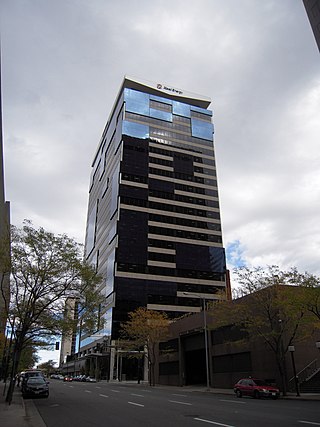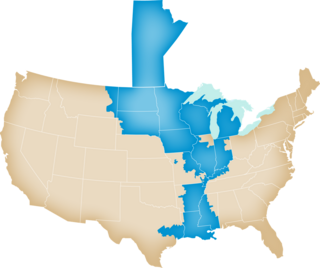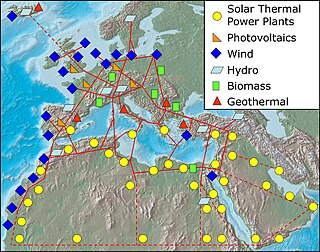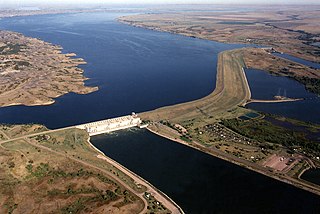Distributed generation, also distributed energy, on-site generation (OSG), or district/decentralized energy, is electrical generation and storage performed by a variety of small, grid-connected or distribution system-connected devices referred to as distributed energy resources (DER).

The electric power industry covers the generation, transmission, distribution and sale of electric power to the general public and industry. The commercial distribution of electric power started in 1882 when electricity was produced for electric lighting. In the 1880s and 1890s, growing economic and safety concerns lead to the regulation of the industry. What was once an expensive novelty limited to the most densely populated areas, reliable and economical electric power has become an essential aspect for normal operation of all elements of developed economies.

Xcel Energy Inc. is a U.S. regulated electric utility and natural gas delivery company based in Minneapolis, Minnesota, serving more than 3.7 million electric customers and 2.1 million natural gas customers across parts of eight states. It consists of four operating subsidiaries: Northern States Power-Minnesota, Northern States Power-Wisconsin, Public Service Company of Colorado, and Southwestern Public Service Co.

A regional transmission organization (RTO) in the United States is an electric power transmission system operator (TSO) that coordinates, controls, and monitors a multi-state electric grid. The transfer of electricity between states is considered interstate commerce, and electric grids spanning multiple states are therefore regulated by the Federal Energy Regulatory Commission (FERC). The voluntary creation of RTOs was initiated by FERC Order No. 2000, issued on December 20, 1999. The purpose of the RTO is to promote economic efficiency, reliability, and non-discriminatory practices while reducing government oversight.
Basin Electric Power Cooperative is a wholesale electric generation and transmission cooperative based in North Dakota that provides electricity to 3 million customers in nine U.S. states. The roots of the cooperative go back to 1960 when Leland Olds and ten power suppliers created Giant Power Cooperative. Giant Power was first going to be a generation and transmission cooperative, but to keep electricity cheaper for rural customers, Basin Electric Power Cooperative was started in 1961. Today, Basin Electric's power sources include coal, natural gas, hydroelectric, wind, waste heat, and nuclear. The current CEO and General Manager is Todd Telesz. A subsidiary of Basin Electric, Dakota Gasification Company, operates the Great Plains Synfuels Plant, which captures and sequesters nearly 50% of its carbon dioxide emissions in a system developed during the Carter administration. In 2005, the membership of Basin Electric passed a resolution requiring 10 percent of electricity demand to be provided by renewable forms of energy. At the end of 2009, Basin Electric finished construction on a 77 turbine wind energy project.
Silicon Valley Power (SVP) is a not-for-profit municipal electric utility owned and operated by the City of Santa Clara, California, USA. SVP provides electricity service to approximately 55,116 residential and business customers, including large corporations such as Intel, Applied Materials, Owens Corning and NVIDIA. SVP also owns and maintains a dark fiber network named SVP Fiber Enterprise.

The Texas Interconnection is an alternating current (AC) power grid – a wide area synchronous grid – that covers most of the state of Texas. The grid is managed by the Electric Reliability Council of Texas (ERCOT).

The Midcontinent Independent System Operator, Inc., formerly named Midwest Independent Transmission System Operator, Inc. (MISO) is an Independent System Operator (ISO) and Regional Transmission Organization (RTO) providing open-access transmission service and monitoring the high-voltage transmission system in the Midwest United States and Manitoba, Canada and a southern United States region which includes much of Arkansas, Mississippi, and Louisiana. MISO also operates one of the world's largest real-time energy markets. The 15 states covered by MISO are: Arkansas, Illinois, Indiana, Iowa, Kentucky, Louisiana, Michigan, Minnesota, Mississippi, Missouri, Montana, North Dakota, South Dakota, Texas, and Wisconsin.

Community wind projects are locally owned by farmers, investors, businesses, schools, utilities, or other public or private entities who utilize wind energy to support and reduce energy costs to the local community. The key feature is that local community members have a significant, direct financial stake in the project beyond land lease payments and tax revenue. Projects may be used for on-site power or to generate wholesale power for sale, usually on a commercial-scale greater than 100 kW.

A super grid or supergrid is a wide-area transmission network, generally trans-continental or multinational, that is intended to make possible the trade of high volumes of electricity across great distances. It is sometimes also referred to as a "mega grid". Super grids typically are proposed to use high-voltage direct current (HVDC) to transmit electricity long distances. The latest generation of HVDC power lines can transmit energy with losses of only 1.6% per 1,000 km.

At the end of 2016, the installed capacity for wind power in Minnesota was 3,500 megawatts (MW). Wind power generated nearly 18 percent of Minnesota’s electricity in 2016, ranking sixth in the nation for wind energy as a share of total electricity generation.
There is a large array of stakeholders that provide services through electricity generation, transmission, distribution and marketing for industrial, commercial, public and residential customers in the United States. It also includes many public institutions that regulate the sector. In 1996, there were 3,195 electric utilities in the United States, of which fewer than 1,000 were engaged in power generation. This leaves a large number of mostly smaller utilities engaged only in power distribution. There were also 65 power marketers. Of all utilities, 2,020 were publicly owned, 932 were rural electric cooperatives, and 243 were investor-owned utilities. The electricity transmission network is controlled by Independent System Operators or Regional Transmission Organizations, which are not-for-profit organizations that are obliged to provide indiscriminate access to various suppliers to promote competition.
Bombard Renewable Energy is an American provider of renewable energy services located in Nevada at Las Vegas. Bombard's primary services include the design, financing, construction, installation, operations, and maintenance of solar photovoltaic ("PV") energy systems. Additionally, Bombard performs energy efficiency audits, designs, and constructs mobile solar PV charging stations. Bombard specializes in building solar power systems that use solar photovoltaic (PV), wind energy and concentrated PV, also known as CSPV.

Renewable energy in South Dakota involves production of biofuels and generation of electricity from renewable sources of energy such as wind and hydropower. South Dakota is among the states with the highest percentage of electricity generation from renewable resources, typically over 70 percent. In 2011, South Dakota became the first U.S. state to have at least 20% of its electricity generation come from wind power.

Solar power in Iowa is limited but growing, with 137 megawatts (MW) installed by the end of 2019 and 27 MW installed during that year, ranking the state 40th among U.S. states. Iowa also generated 0.23% of the state's total electricity production in 2019 from solar energy; an amount sufficient to power over 17,000 Iowa homes. The state's early position as a major wind-power provider may have limited early large-scale solar investment.

Solar power in Minnesota expanded significantly in the early 2010s as a result of the cost decrease of photovoltaics and favorable policies. By 2016, it began to grow quickly.
The United States state of Arkansas is a significant producer of natural gas and a minor producer of petroleum.

The electrical power grid that powers Northern America is not a single grid, but is instead divided into multiple wide area synchronous grids. The Eastern Interconnection and the Western Interconnection are the largest. Three other regions include the Texas Interconnection, the Quebec Interconnection, and the Alaska Interconnection. Each region delivers power at a nominal 60 Hz frequency. The regions are not usually directly connected or synchronized to each other, but there exist some HVDC interconnectors. The Eastern and Western grids are connected via seven links that allow 1.32 GW to flow between them. A study by the National Renewable Energy Laboratory found that increasing these interconnections would save energy costs.













